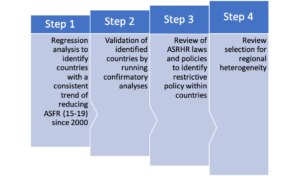Exemplars in Adolescent Sexual and Reproductive Health (ASHER)



Adolescence (the period between 10 – 19 years of age) is a phase of physical and emotional growth often accompanied by sexual curiosity and experimentation. Annually, about 21 million adolescent girls aged 15 – 19 years become pregnant in low-and middle-income countries with almost half of the pregnancies being unintended. Teenage pregnancies continue to be a public health problem across the globe due to the increased risks of complications such as puerperal endometritis, eclampsia and systemic infections.Over the last 30 years, the median age at first sexual intercourse among women aged 25 – 49 years only increased by half a year whilst the median age at first marriage increased by over 1 year thereby implying increased sexual activity outside marriage. High rates of child marriage also continue to exist in Central Africa (45%), Eastern and Southern Africa (35%) and Southern Asia (30%). Whilst adolescent sexual activity within marriage is not as stigmatized as outside marriage, it may not always lead to good outcomes.The policy and program contexts for adolescent sexual and reproductive health and rights (ASRHR) are defined by global development frameworks such as the Sustainable Development Goals (SDGs) #3 and #5, “ensuring universal access to sexual and reproductive health-care services, including for family planning, information and education, and the integration of reproductive health into national strategies and programmes” by 2030. Several frameworks have also been developed to aid the development of sexual and reproductive health services across the globe. However, there is still significant work to be done to meet the needs of adolescents in many LMICs.Whilst some countries have implemented interventions that have contributed to the reduction in teenage pregnancies and adolescent fertility, many LMICs continue to have significantly high rates of adolescent pregnancy.The Exemplars in Adolescent Sexual and Reproductive Health (ASHER) project is a two-year project that seeks to identify low- and middle-income countries (LMICs) that have made exemplary progress in reducing adolescent fertility rates. This work will provide evidence of impactful adolescent sexual and reproductive health (ASRHR) interventions and provide lessons to other LMICs on how they can implement similar interventions in their countries to reduce adolescent fertility rates.The policy and program contexts for adolescent sexual and reproductive health and rights (ASRHR) are defined by global development frameworks such as the Sustainable Development Goals (SDGs) #3 and #5, “ensuring universal access to sexual and reproductive health-care services, including for family planning, information and education, and the integration of reproductive health into national strategies and programmes as agreed in accordance with the Programme of Action of the International Conference on Population and Development and the Beijing Platform for Action” by 2030.
Our objectives are to;
- Identify up to five LMIC exemplar countries which have successfully reduced ASFR and have a good trajectory of further reductions in comparison to other LMICs
Country selection process 2. Understand key drivers (legal, policy, programmatic, socio-economic, and health systems) of success in the exemplar countries.3. Assess the scalability, sustainability and replicability of interventions and approaches implemented in exemplar countries.4. Facilitate uptake of findings within lower performing regions of exemplar countries, as well as in other countries.
2. Understand key drivers (legal, policy, programmatic, socio-economic, and health systems) of success in the exemplar countries.3. Assess the scalability, sustainability and replicability of interventions and approaches implemented in exemplar countries.4. Facilitate uptake of findings within lower performing regions of exemplar countries, as well as in other countries.
- Identification of 5 exemplar LMICs
- Identification of success factors for adolescent SRHR in exemplar countries
- Identification of scalable interventions
The Exemplars in Adolescent Sexual and Reproductive Health project received funding from a Large Anonymous Donor through Gates Ventures.
Key Details
| Dates: | March 2022 to March 2022 |
| Aim: | The Exemplars in Adolescent Sexual and Reproductive Health (ASHER) project seeks to identify countries that have made exemplary progress in reducing adolescent fertility rates/teenage pregnancies compared to their counterparts. |
| Where: | Africa |
| Project Manager: | Naa Dodoo, Ph.D. |
| Principal Investigator: | Prof. Nyovani Madise |

